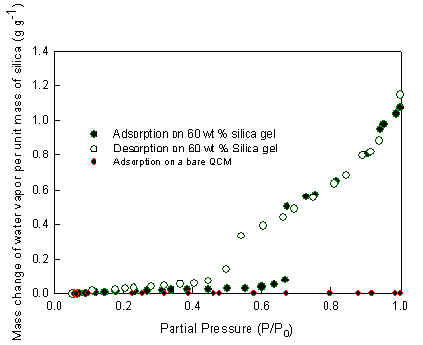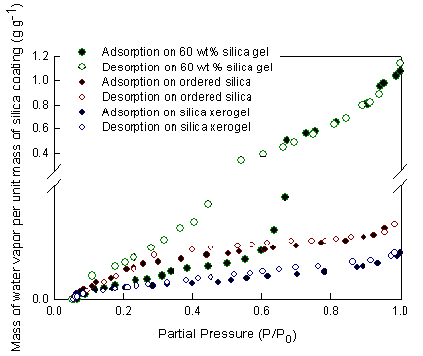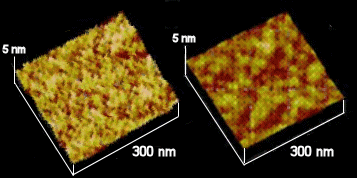Research: Nanoporous Silica / Piezoelectric Cantilevers for Biosensing Applications
Shilpa H. Bhansali
Advisors: Jeffrey D. Carbeck and Ilhan A. Aksay
Our goal is to formulate and characterize piezoelectric biosensors that present high surface area nanoporous coatings for increased sensitivity in detection. The nanoporous silica coating we are using for this work is a surfactant templated disordered silica material known as L3 silica by virtue of the L3 liquid crystal structure of the template.[1,2]
We have demonstrated an enhanced sensitivity of a piezoelectric resonator such as a quartz crystal microbalance (QCM) by depositing a thin film of the high surface area material on the surface of the electrodes of the crystal. The QCM/nanoporous L3 silica has been shown to increase the sensitivity in the detection of water vapor by 50 fold. Below is the water vapor isotherm generated by a thin film of surfactant templated silica on the QCM electrodes compared to the isotherm generated by a QCM crystal used as is.[3]

Additionally, the structural differences within the nanostructured coatings affect the sensitivity of the silica/QCM composite used for sensing. We have shown this experimentally using both, an ordered surfactant templated silica coating[4] as well as a silica xerogels coating (synthesized without a structure directing agent). The silica xerogel film proves to be limited by a smaller channel dimension whereas, the ordered surfactant templated silica coating is limited by the orientation of the channels as well as the channel dimensions which is restricted by the template size available. An additional drawback of the ordered surfactant templated films is that in order to gain access to the channels, the amphiphilic material needs to be removed. The L3 liquid crystal templated silica film has shown to overcome the existing limitations of silica xerogel by presenting larger channels and that of the ordered surfactant templated silica by presenting a disordered, accessible framework of interpenetrating channels.

The films have been characterized using atomic force microscopy (AFM) as well as SEM. Below we have AFM images of a silica xerogel film compared to a film of the surfactant templated L3 silica. At a nanometer length scale, the surfactant templated silica films show larger characteristic dimensions that make it advantageous for sensing applications.

AFM images of a silica xerogel film (left) and a L3 surfactant-templated silica film (right).
We are currently in the process of demonstrating the application of the L3 nanoporous silica/piezoelectric composite in other sensing applications.
References
1. K. M. McGrath, D. M. Dabbs, N. Yao, K. J. Edler, I. A. Aksay, and S. M. Gruner Langmuir 16 (2000).
2. K. M. McGrath, D. M. Dabbs, N. Yao, I. A. Aksay, and S. M. Gruner, Science 277 (1997).
3. S. Bhansali, J. Jarvis, D. M. Dabbs, J. D. Carbeck, and I. A. Aksay, unpublished research
4. Y. Lu, R. Ganguli, C. A. Drewien, M. T. Anderson, C. J. Brinker, W. Gong, Y. Guo, H. Soyez, B. Dunn, M. H. Huang, and J. I. Zink, Letters to Nature 1997, 389, 364-368.
For more information on this research topic, please contact Shilpa Bhansali. Additional information concerning the CML can be found on our website.
![]()
![]()
![]() © 2004 Princeton University, Ceramic Materials Laboratory.All Rights Reserved.
© 2004 Princeton University, Ceramic Materials Laboratory.All Rights Reserved.


